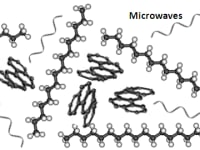The core idea behind this proposal is the scientific expectation that surface functionalized carbonaceous nanoparticle containing pre-heated diesel engine fuel (petrodiesel, biodiesel etc.) would have increased molecular kinetic energy and better reaction characteristics resulting in a more efficient and greener combustion process.
When exposed to certain microwave spectra, graphitic nanoparticles tend to absorb directed energy instantaneously owing to their intrinsic dielectric properties and enhanced quantum rotational resonances induced by the presence of polar functional side group chains on their surface [1]. Entrapped microwave energy will be immediately converted into heat and transferred to fuel molecules in the immediate vicinity of the excited functionalized graphitic nanoparticle thus presenting an extremely quick and energy efficient fuel pre-heating opportunity before combustion.
Graphitic nanoparticles suitable for this purpose can be cost-effectively fabricated by subjecting low-cost, easy to functionalize vapor grown carbon nanofibers (VGCNF) to ultrasonication so that particle size can be optimized. Surface functionalization of graphitic nanoparticles can be performed with existing oxygen carriers and combustion promoters [2-3] so that near-ideal reaction yield can be sustained at the combustion front after fuel injection during power stroke. Fuel pre-heating combined with the action of uniformly dispersed oxygen delivery agents and combustion promoters is expected to lead to significant reduction in unburned fuel, soot, CO and NOX formation thus reversing the effect of EGR (exhaust gas recirculation) in terms of combustion efficiency and power output. Since autoignition temperatures of various kinds of diesel fuel range from 450 K to 558 K [4], it is possible to heat up only required amounts of functionalized graphitic nanoparticle containing fuel as determined by the EIS (electronic injection system) to 448 K (175?C) just before spraying.
No substantial modification or reengineering of the state of the art diesel engine technology is needed since a miniaturized microwave pre-heater can be easily integrated to the fuel line between storage tank and injection system. The anticipated high-level compatibility of the proposed microwave assisted pre-heater with already in use diesel engines renders it ideal for wide-scale adaptation in automotive and high-powered engine manufacturing industries. Once technical feasibility and beneficial sustainability aspects of the proposed idea are approved through objective engineering assessment studies, global market penetration can be coordinated by a non-profit consortium of OEMs and governmental/non-governmental environmental protection agencies.
With my best regards,
Tanil Ozkan
Graduate Research Assistant
Nanomechanics and Materials Research Lab.
University of Illinois at Urbana-Champaign
REFERENCES
[1] Microwave-Enhanced Polymer Chemistry and Technology, D. Bogdal and A. Prociak, Nanocomposites, 184-197, Wiley-Blackwell Publishing, Iowa, 2007
[2] http://www.cerionenergy.com/articles/6
[3] http://www.cdc.gov/niosh/mining/pubs/pdfs/ri9438.pdf
[4] http://hypertextbook.com/facts/2005/EileenTang.shtml
[5] Simplified side-view of the power stroke of a four-stroke-cycle diesel engine is taken from ‘Small Engines: Operation and Service’ of J. Webster published by American Technical Publishers in 1981.
Like this entry?
-
About the Entrant
- Name:Tanil Ozkan
- Type of entry:individual
- Software used for this entry:Chem3D, UIUC doesn't provide COMSOL whose reaction module would be very useful for stoichiometry
- Patent status:none





